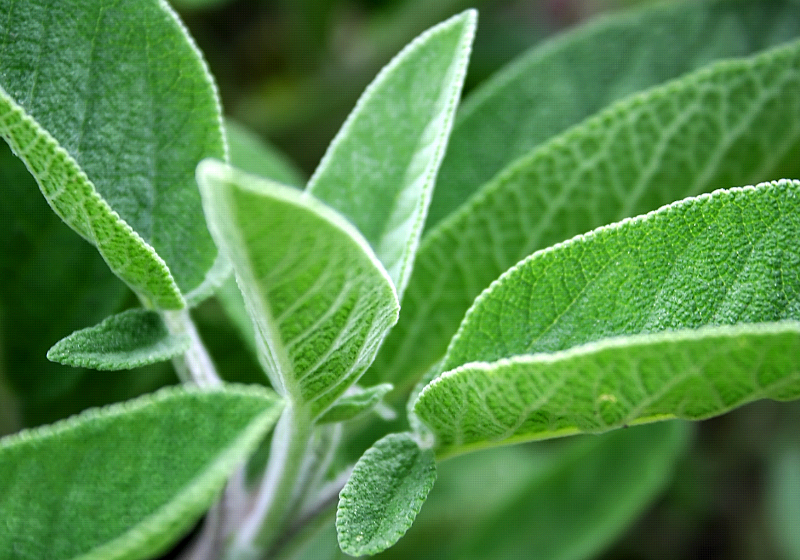A native of the Mediterranean region, it is widely used in dishes around the world. Leaves are commonly used to flavor soups, stews, meats, and vegetables; some people steep dried sage leaves to make an herbal tea. Sage and onion make a good combination and are traditionally used together in stuffing for pork, turkey, or duck. Sage can overwhelm other seasonings, so handle it with care. The plant also attracts bees and makes an excellent ornamental in the garden
Where to Grow Sage
Sage, like most herbs, is an accommodating plant that will grow almost anywhere. In northern areas, mulch to help the plants survive the winter. They should be located in full sun; the plant will tolerate partial shade, but the flavor will be impaired.
Soil for Sage
The most important soil characteristic is that is should be well-drained. As with other herbs, sage should be grown in poor soil, which will aid in the production of essential oils and give the herbs a stronger flavor. If fertilized, the plants will grow prolifically but will have little taste. If you’re planting sage as a perennial, fertilize the first year only with a low-nitrogen fertilizer. When you’re preparing the soil for planting, work a 5-10-10 fertilizer into the soil at the rate of half a pound per 100 square feet.
Planting Sage
When –
Seeds require 20 days at 70°F to germinate. Sage can be reproduced by layering, by division, or by using stem cuttings. You can also start it from seed—plant sage seeds or divisions on your average date of last frost.
How –
Plant seeds 1/4″ deep in rows 18 to 24 inches apart, and thin to 12 inches apart. Plant divisions or cuttings 12 inches apart in rows 18 to 24 inches apart.
| Temperature | |
| Germination | 60 - 70 F |
| For Growth | Warm |
| Soil and Water | |
| Fertilizer | Not necessary |
| pH | 4.2 - 8.3 |
| Water | Average |
| Measurements | |
| Planting Depth | 1/4" |
| Root Depth | 14"+ |
| Height | 30" |
| Width | 24" |
| Space between plants | |
| In beds | 12" |
| in rows | 12" |
| space between rows | 18 - 24" |
| Companions | |
| Companions | Beans, Cabbage, Carrot, Marjoram, Peas, Rosemary, Strawberry, Tomato |
| Incompatibles | Cucumber |
| Harvest | |
| Pinch off leaves as needed. Stop harvesting in early fall so the plants can harden off for winter. | |
Cultivating Sage
Sage requires very little care. It is very drought-tolerant and likes it a little on the dry side. It does not require any fertilization. Cut back the flower stems to encourage new growth.
| Storage Requirements | |
|---|---|
| Store fresh sage leaves in plastic bags in the refrigerator. Retain flavor by freezing sage. Either freeze entire branches on cookie sheets, then strip the leaves from stems and put into plastic bags into the freezer, or mix finely chopped sage leaves with just enough olive oil to bind them together, and freeze the mixture in ice cube trays. Alternatively, dry sage leaves on screens in a dry spot away from direct sun. Store dried sage leaves in an airtight container. | |
| Method | Taste |
| Fresh | Excellent; cuttings last 2-7 days in the refrigerator |
| Dried | Fair |
| Frozen | Good |
How Sage Grows
Sage is a hardy evergreen shrub of which there are several varieties, all with slightly different flavors. The most commonly grown is salvia officinalis, a small woody perennial that grows to about 1 inch in height and is quite shrubby in appearance. It has oblong, veined leaves that look pebbly and grayish-green in color with velvet-like texture. The flowers appear in late summer and are white to purple and grow on spike-like stems with a spicy scent. Gray leaves are more common, but several varieties have variegated leaf color. The purple or golden varieties make delightful ornamental houseplants. They’re smaller plants than the green or gray varieties, but they’re prettier, and the flavor is just as good. Most garden shops and catalogs offer only the gray varieties. Go to a herb specialist for the less common types.
Harvesting Sage
When to Harvest Sage
Sage can be harvested about 75 days after transplanted to your garden. A few plants will easily supply plenty for yourself as well as your neighbors. At least twice during the growing season, cut six to eight inches from the plants’ top. This allows vigorous growth throughout the season.
How to Harvest Sage
Pick the leaves as desired as long as you don’t cut back more than half the plant; if you do, it will stop producing. Store dried sage leaves in an airtight container. Harvest sage on a clear day after the dew has dried on the leaves, but before the sun’s heat can dissipate the essential oils that give the herb its flavor and aroma. Frozen sage tastes much better than the dried form, but it appears limp and unattractive. Use it in stews, casseroles, and other dishes when taste matters more than appearance.
Sage Pests
Sage has no serious pest problems.
Sage Disease
Sage has no serious disease problems, but if the area is too damp or shady, rot may occur. Avoid this by planting sage in a dry, sunny location.

1 comment
Just what I was looking for. Very thorough information.